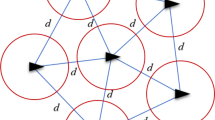Abstract
This paper proposes a modified Couzin and velocity-adaptive Couzin flocking model based on fuzzy rules. In the models, agents update their positions through a fuzzy-rule-based decision-making scheme in three perception zones. Stability of the systems are guaranteed. Simulations demonstrate that the convergence probability and relative converging size are both improved.
Similar content being viewed by others
References
J. Toner, Y. Tu. Flocks, herds, and schools: a quantitative theory of flocking. Physical Review E, 1998, 58(4): 4828–4858.
D. Cheng, H. Chen. From the flocking to control social behavior. Technology Review, 2004, 8: 4–6.
A. Okubo. Dynamical aspects of animal grouping: swarms, schools, flocks and herds. Advance Biophysics, 1986, 22: 1–94.
B. Ermentrout, K. Edelstein. Cellular automata approaches to biological modeling. Journal of Theoretical Biology, 1993, 180(1):97–133.
R. Vaboe, L. Noetiestad. An individual based model of fish school reactionspredicting antipredator behaviour as observed in nature. Fisheries Oceanography, 1997, 6(3): 155–171.
D. Zhou, R. Dai. Adaptive behavior and simulation. System Simulation, 2000, 12(6): 578–583.
D. Morale. Modeling and simulating animal grouping individual based models. Future Generation Computer Systems, 2001, 17(7):883–891.
B. Liu, T. Chu, L. Wang. Collective motion in non-reciprocal swarms. Journal of Control Theory and Applications, 2009, 7(2): 105–111.
V. Gazi, M. Passino. Stability analysis of swarms. IEEE Transations on Automatic Control, 2003, 48(4): 692–697.
V. Gazi, M. Passino. A class of attraction/repulsion functions for stable swarm aggregation. International Journal of Control, 2004, 77(18): 1567–1579.
S. R. Olfati. Hocking for multi-agent dynamic systemsalgorithms and theory. IEEE Transations on Automatic Control, 2006, 51(3): 401–420.
H. Su, X. Wang. Second-order consensus of multiple agents with coupling delay. The 7th World Congress on Intelligent Control and Automation, Chongqing, 2008: 7181–7186.
Z. Li, Y. Jia. Flocking for swarm systems with fixed topology in a changing environment. Journal of Control Theory and Applications, 2008, 6(3): 333–339.
H. Shi, L. Wand, T. Chu. Swarming behavior of multi-agent systems. Journal of Control Theory and Applications, 2004, 2(4): 313–318.
T. Chu, L. Wang, T. Chen. Self-organized motion in anisotropic swarms. Journal of Control Theory and Applications, 2003, 1(1): 77–81.
A. Jadbabale, J. Hn, A. S. Morse. Coordination of groups of mobile autonomous agents using nearest neighbor rules. IEEE Transactions on Automatic Control, 2003, 48(6): 988–1001.
V. Gazi, K. M. Passino. Stability analysis of social foraging swarlns. IEEE Transations on SystemsManand Cybernetics — Part B: Cybernetics, 2004, 34(1): 539–556.
S. Zhang, G. Duan. Consensus seeking in multiagent cooperative control systems with bounded control input. Journal of Control Theory and Applications, 2011, 9(2): 210–214.
J. Yan, X. Guan, X. Luo, et al. Formation and obstacle avoidance control for multiagent systems. Journal of Control Theory and Applications, 2011, 9(2): 141–147.
Y. Lu, Y. Guo, Z. Dong. Multiagent flocking with formation in a constrained environment. Journal of Control Theory and Applications, 2010, 8(2): 151–159.
J. Kuang, J. Zhu. On consensus protocols for high-order multiagent systems. Journal of Control Theory and Applications, 2010, 8(4): 406–412.
C. Reynolds. Flocks, herds, and schools: a distributed behavior model. Computer Graphics, 1987, 21(4): 25–34.
T. Vicsek, A. Czirok. Novel type of phase transition in a system of self-driven particles. Physical Review Letters, 1995, 75(6): 1226–1229.
I. D. Couzin, J. Krause, R. James, et al. Collective memory and spatial sorting in animal groups. Journal of Theoretical Biology, 2002, 218(1): 1–11.
H. Dong, Y. Zhao, J. Wu, et al. A velocity-adaptive Couzin model and its performance. Physica A, 2012, 391(5): 2145–2153.
Author information
Authors and Affiliations
Corresponding author
Additional information
This work was supported by the National Natural Science Foundation of China (No. 61233001), the Fundamental Research Funds for Central Universities (No. 2013JBZ007), and the Beijing Jiaotong University Research Program (No. RCS2012ZZ003).
Hairong DONG received her B.S. and M.S. degrees in Automatic Control and Basic Mathematics from Zhengzhou University, Zhengzhou, China, in 1996 and 1999, respectively, and Ph.D. degree in General and Fundamental Mechanics from Peking University, Beijing, China, in 2002. She is currently a professor with the State Key Laboratory of Rail Traffic Control and Safety, Beijing Jiaotong University. She was a visiting scholar with the University of Southampton, Southampton, U.K., in 2006; the University of Hong Kong, Pokfulam, Hong Kong, in 2008; the City University of Hong Kong, Kowloon, Hong Kong, in 2009; the Hong Kong Polytechnic University, Kowloon, in 2010; and KTH Royal Institute of Technology, Sweden, in 2011. In 2007, she served as a project level-3 expert with the Department of Transportation for the Beijing Organizing Committee for the Olympic Games. Her research interests include stability and robustness of complex systems control theory, intelligent transportation systems, automatic train operation, and parallel control and management for urban rail transportation systems and high-speed railway systems.
Yan ZHAO received her B.S. degree from School of Computer and Information Engineering, Chongqing Technology and Business University, Chongqing, China in 2008, and M.S. degree from School of Electronic and Information Engineering, Beijing Jiaotong University, Beijing, China in 2012. Her primary research interests is flocking control based on multi-agents.
Shigen GAO received his B.S. degree in Electrical Engineering and Automation from Tianjin University of Technology, Tianjin, China, in 2009, and is pursuing the Ph.D. degree at Beijing Jiaotong University, Beijing, China. From August to November 2011, he was a research assistant in the City University of Hong Kong. His primary research interests are automatic train operation, optimal control, parallel control and management for urban rail transportation systems and high-speed railway systems.
Rights and permissions
About this article
Cite this article
Dong, H., Zhao, Y. & Gao, S. A fuzzy-rule-based Couzin model. J. Control Theory Appl. 11, 311–315 (2013). https://doi.org/10.1007/s11768-013-1193-0
Received:
Revised:
Published:
Issue Date:
DOI: https://doi.org/10.1007/s11768-013-1193-0




